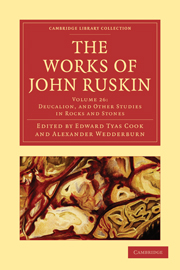Book contents
- Frontmatter
- Contents
- LIST OF ILLUSTRATIONS
- INTRODUCTION TO THIS VOLUME
- I ON THE FORMS OF THE STRATIFIED ALPS OF SAVOY (1863)
- II NOTES ON THE SHAPE AND STRUCTURE OF SOME PARTS OF THE ALPS, WITH REFERENCE TO DENUDATION (1865)
- III ON BANDED AND BRECCIATED CONCRETIONS (1867–1870)
- IV DEUCALION: COLLECTED STUDIES OF THE LAPSE OF WAVES AND LIFE OF STONES (1875–1883)
- V ON THE DISTINCTIONS OF FORM IN SILICA (1884)
- VI CATALOGUES OF MINERALS
- 1 CATALOGUE OF A SERIES OF SPECIMENS IN THE BRITISH MUSEUM (NATURAL HISTORY) ILLUSTRATIVE OF THE MORE COMMON FORMS OF NATIVE SILICA (1884)
- 2 CATALOGUE OF MINERALS IN ST. GEORGE'S MUSEUM, SHEFFIELD (1877–1886)
- 3 CATALOGUE OF FAMILIAR MINERALS IN THE MUSEUM OF KIRKCUDBRIGHT (1884)
- 4 CATALOGUE OF THE COLLECTION OF SILICEOUS MINERALS GIVEN TO AND ARRANGED FOR ST. DAVID'S SCHOOL, REIGATE, BY JOHN RUSKIN (1883)
- 5 CATALOGUE OF MINERALS PRESENTED TO THE CONISTON INSTITUTE (1884)
- 6 CATALOGUE OF MINERALS SHOWN AT EDINBURGH (1884)
- 7 NOTES ON MINOR COLLECTIONS
- VII THE GRAMMAR OF SILICA (not hitherto published)
- APPENDIX: LETTERS, ADDRESSES, AND NOTES
- INDEX
- Plate section
3 - CATALOGUE OF FAMILIAR MINERALS IN THE MUSEUM OF KIRKCUDBRIGHT (1884)
Published online by Cambridge University Press: 05 March 2012
- Frontmatter
- Contents
- LIST OF ILLUSTRATIONS
- INTRODUCTION TO THIS VOLUME
- I ON THE FORMS OF THE STRATIFIED ALPS OF SAVOY (1863)
- II NOTES ON THE SHAPE AND STRUCTURE OF SOME PARTS OF THE ALPS, WITH REFERENCE TO DENUDATION (1865)
- III ON BANDED AND BRECCIATED CONCRETIONS (1867–1870)
- IV DEUCALION: COLLECTED STUDIES OF THE LAPSE OF WAVES AND LIFE OF STONES (1875–1883)
- V ON THE DISTINCTIONS OF FORM IN SILICA (1884)
- VI CATALOGUES OF MINERALS
- 1 CATALOGUE OF A SERIES OF SPECIMENS IN THE BRITISH MUSEUM (NATURAL HISTORY) ILLUSTRATIVE OF THE MORE COMMON FORMS OF NATIVE SILICA (1884)
- 2 CATALOGUE OF MINERALS IN ST. GEORGE'S MUSEUM, SHEFFIELD (1877–1886)
- 3 CATALOGUE OF FAMILIAR MINERALS IN THE MUSEUM OF KIRKCUDBRIGHT (1884)
- 4 CATALOGUE OF THE COLLECTION OF SILICEOUS MINERALS GIVEN TO AND ARRANGED FOR ST. DAVID'S SCHOOL, REIGATE, BY JOHN RUSKIN (1883)
- 5 CATALOGUE OF MINERALS PRESENTED TO THE CONISTON INSTITUTE (1884)
- 6 CATALOGUE OF MINERALS SHOWN AT EDINBURGH (1884)
- 7 NOTES ON MINOR COLLECTIONS
- VII THE GRAMMAR OF SILICA (not hitherto published)
- APPENDIX: LETTERS, ADDRESSES, AND NOTES
- INDEX
- Plate section
Summary
The arrangement of minerals adopted in the following Catalogue, though unsystematic according to the views of modern mineralogists, is an old-fashioned one, which will be found far more useful, in familiarizing the student quickly and easily with the general aspects of the mineral kingdom. These he will find himself at liberty, as his knowledge advances, to systematize either at his own pleasure or under the direction of his tutors;—but I would request that the numbers, attached to my specimens, be preserved: because I am at present endeavouring to organize a system of mineralogical instruction for schools, in which the accessible specimens to which it will refer, in provincial towns, may be permanently connected by their numbers, both with each other, and with the great central examples of mineralogical structure, which have just been so admirably arranged under the windows of the north side of the mineral gallery in the British “Natural History Museum” at Kensington.
PART I.—METALLIC MINERALS
GROUP I
Metals found in the Native State
GOLD, SILVER, COPPER, TELLURIUM
GOLD
Native gold, dispersed in quartz, and associated with the sulphurets of lead and iron. This specimen is quite characteristic of the mode in which gold generally occurs in Australia, California, and Nova Scotia, but this particular specimen is, I believe, an unusually rich one, from Dolgelly in North Wales.
Native gold, delicately crystallized, sprinkled on the wall of a vein, previously lined by quartz. I have no doubt that this example is from Boitza in Transylvania. See notes on Transylvanian gold in the St. David's Catalogue [below, p. 496, No. 35].
[…]
- Type
- Chapter
- Information
- The Works of John Ruskin , pp. 457 - 486Publisher: Cambridge University PressPrint publication year: 2010First published in: 1906

